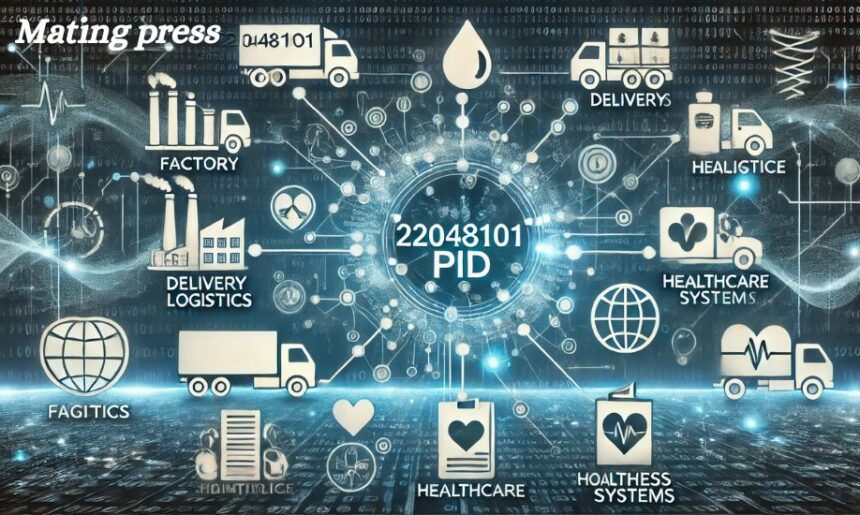Welcome to another insightful article brought to you by Mating Press, where we dive deep into technical and industrial topics. Today’s article focuses on the “22048101 PID,” a unique identifier with wide-ranging applications across various industries. While the term may seem like just a random set of numbers, it holds immense significance in modern systems, particularly in control systems, manufacturing, logistics, and even software development.
In this detailed exploration, we will uncover the meaning of 22048101 PID, its applications, and why it is so important in today’s highly interconnected world. You’ll also learn how businesses use it to streamline processes and ensure accuracy. If you’re intrigued by technological identifiers and their impact, keep reading to discover the power of 22048101 PID.
What is 22048101 PID?
At its core, 22048101 PID is a Product Identification or Process Identification code, designed to manage and monitor tasks or products within a system. In computing, a PID (Process Identification Number) refers to a unique number assigned to a running process. Similarly, in industries like manufacturing or healthcare, PIDs serve as a way to track goods, parts, and products across different stages of production, logistics, or even usage.
The term “22048101 PID” might represent a specific product or a process in different contexts. For example, in control systems, this could be an identifier that plays a role in maintaining accuracy within automated tasks, helping industries achieve higher precision and control. Let’s delve deeper into its applications and see how such a small identifier plays an enormous role in various industries.
Importance of 22048101 PID in Control Systems
In industrial automation, a control system’s efficiency and accuracy depend on mechanisms like PID algorithms, which adjust and fine-tune processes for optimal performance. The 22048101 PID represents an essential component in this, ensuring smooth operations in industries such as aerospace, automotive, and energy sectors. These sectors rely on the precision of 22048101 PID to maintain process stability and provide feedback for real-time adjustments.
For instance, in robotics or automated machinery, control systems utilize PID loops that take input from sensors and adjust the machinery’s operation to ensure accuracy. This is critical for industries that rely on fast, precise movements or environmental conditions, such as packaging plants or automated warehouses.
Emerging trends, such as integrating artificial intelligence and IoT (Internet of Things), have made 22048101 PID systems even more responsive. They can now make predictive adjustments, learning from past behaviors to optimize processes before problems even occur. This predictive approach revolutionizes control systems, improving efficiency and reducing downtime.
22048101 PID in Manufacturing and Logistics
Manufacturing industries extensively use Product Identification (PID) systems like 22048101 PID to track goods throughout their lifecycle. From raw materials to finished products, everything is labeled with a unique PID. In large-scale manufacturing, PIDs ensure that components and finished products are accurately recorded and monitored, reducing the risk of errors.
In the logistics sector, 22048101 PID is invaluable for managing supply chains. Each product or shipment is assigned a unique PID that allows for real-time tracking. For example, logistics companies use PIDs like 22048101 PID to monitor shipments from the warehouse to the customer’s doorstep, providing visibility into each step of the delivery process. This transparency ensures that products reach their destination on time and in good condition, enhancing customer satisfaction.
Additionally, 22048101 PID systems allow manufacturers and logistics providers to manage inventory with pinpoint accuracy. By tracking stock levels and monitoring product locations in real-time, businesses can prevent stockouts and overselling, ensuring a smoother and more reliable supply chain.
Role of 22048101 PID in Healthcare and Pharmaceuticals
Another important application of 22048101 PID lies in the healthcare and pharmaceutical industries. Here, Product Identification codes like 22048101 PID ensure the safety and traceability of medical products. Every medication, device, or treatment is assigned a PID to monitor its lifecycle from production to patient use.
In healthcare, PID systems help track patient records, medical equipment, and drug distributions. This system is particularly critical when recalling defective products or managing the distribution of time-sensitive medications. By using 22048101 PID, healthcare professionals can ensure that every step in the supply chain is traceable, which is vital for maintaining product safety and regulatory compliance.
Pharmaceutical companies also utilize PIDs for batch tracking, ensuring that any recalled product can be identified and pulled from shelves quickly. This contributes to both safety and trust between consumers and providers, further highlighting the importance of accurate tracking.
How 22048101 PID Enhances Efficiency in Software Development
In software development, the use of 22048101 PID is essential for tracking and managing system processes. A PID in software identifies an ongoing process and manages how memory and CPU resources are allocated to it. This becomes particularly important in multitasking environments where multiple processes are running simultaneously.
Imagine your computer running multiple applications like a browser, word processor, and media player. Each of these processes is assigned a unique PID to ensure they don’t interfere with each other. If one process crashes or needs to be terminated, the system can reference its PID to stop it without disrupting other ongoing tasks.
By using PIDs like 22048101 PID, systems can operate more efficiently, minimizing resource conflicts and ensuring smoother operation. This is especially important for large organizations or data centers where dozens, if not hundreds, of processes are being managed at once. In these environments, identifying and troubleshooting faulty processes through their PID is essential for maintaining uptime and performance.
Challenges in Managing 22048101 PID
While the advantages of using 22048101 PID are clear, managing such systems can be complex. One of the primary challenges is ensuring that each PID remains unique across various systems. As industries grow, the number of products, processes, or projects increases, making it more difficult to maintain unique identifiers.
Additionally, with the rise of interconnected devices and IoT technologies, the demand for unique PIDs has skyrocketed. Every new device or system introduced needs its own PID to function correctly within a network. Managing and tracking these identifiers can be a daunting task for industries.
Despite these challenges, advancements such as Universally Unique Identifiers (UUIDs) are being adopted to ensure that every PID remains distinct, even across different systems. These innovations will likely play a role in the evolution of PID systems like 22048101 PID in the future.
Future Trends and Innovations in 22048101 PID
The future of 22048101 PID systems looks promising, with several key trends on the horizon. One of the most exciting developments is the integration of IoT technologies. By connecting PID systems to IoT devices, businesses can gain more detailed insights into their products and processes. This could involve real-time monitoring of product conditions, predictive maintenance, and automated adjustments based on data collected through IoT sensors.
Another significant trend is the incorporation of blockchain technology into PID systems. Blockchain can provide a secure, transparent way to track products through their lifecycle, ensuring that PIDs are tamper-proof and reliable. This would greatly enhance trust and accountability across supply chains.
Additionally, artificial intelligence and machine learning are expected to further enhance PID systems. These technologies will allow businesses to optimize their processes by predicting demand, automating stock replenishment, and improving accuracy in inventory management.
Conclusion
The “22048101 PID” is much more than a simple identifier. It plays a critical role in industries ranging from manufacturing and healthcare to software development. By providing unique identification, 22048101 PID ensures that processes are tracked, monitored, and optimized across various applications.
As Mating Press continues to explore innovative topics, we hope this detailed exploration of 22048101 PID has shed light on its importance and versatility. With future trends pointing toward greater integration with IoT, AI, and blockchain technologies, the potential for 22048101 PID systems to revolutionize industries is immense. Whether in logistics, control systems, or healthcare, 22048101 PID remains a cornerstone of modern systems, driving efficiency and accuracy.





